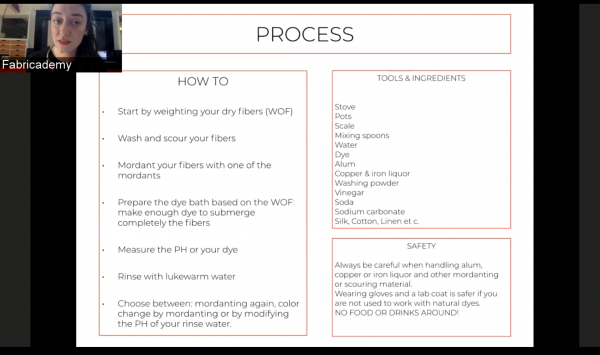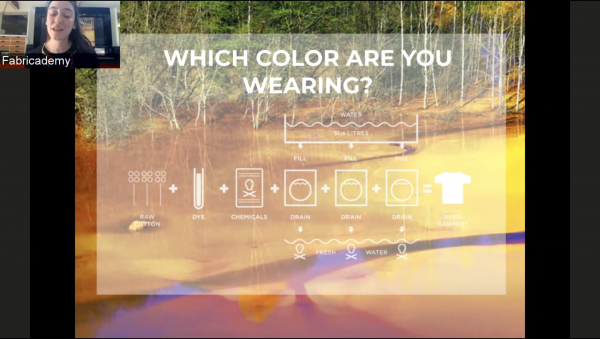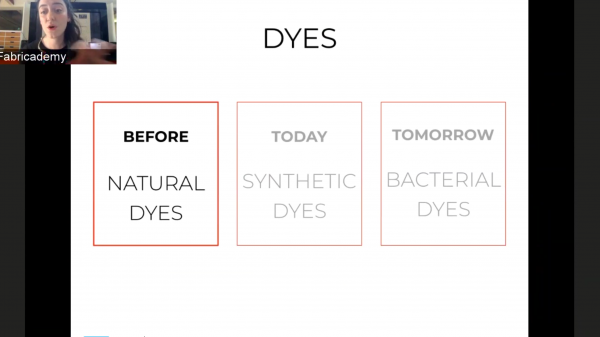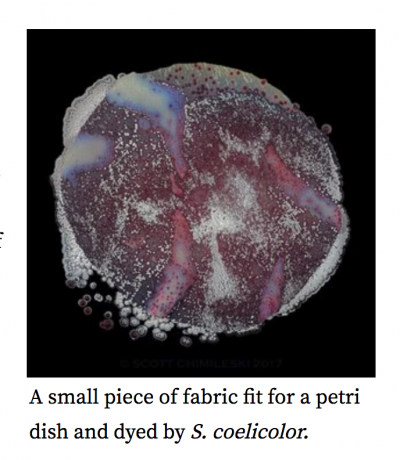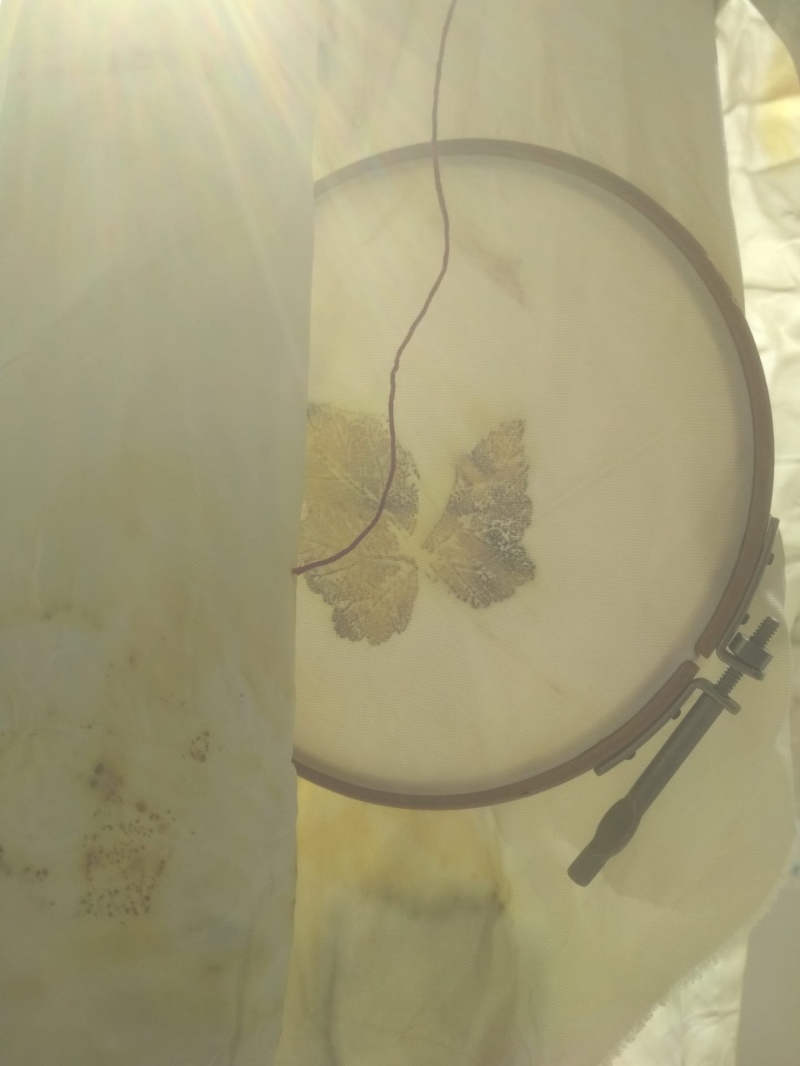DIY or DYE - BadLab project
Link to BAD LAB: https://www.instagram.com/badlabproject/
Contents
- 1 Info
- 2 Lab Equipment:
- 3 Find more sources and information on:
- 4 History from Natural to Synthetic Dyes
- 5 Animal Fibers
- 6 Plant-derived vegetable fibres
- 7 On Natural Dye and sources:
- 8 Natural Products that give dye:
- 9 Ecoprinting - Wildherbs archive:
- 10 Chemicals used in Synth Dye:
- 11 Bacterial Dye
- 12 More Related Links and other projects:
- 13 Links to ethnobotanical References:
Info
DIY or DIE Is an transdisciplinary workshop led by Corinna Mattner and Maya Minder on the topic of coloring fabrics with wild herbs and bacteria, which takes place in the context of the exhibition UNFINISHED BUSINESS at Sattelkammer, Bern.
We will approach the art of dyeing by means of DIYbio methods and old knowledge about plantdye and natural coloring. We use plants, bacteria and ferments directly to dye fabrics and create uncontrolled design and patterns. In the framework of the theme of the exhibition „unfinished business“ the aspect of empowerment by DIY is celebrated threw the moment of liberation - Just do it! Embroidery hoops stand as a symbol of the time we save, which we take as free time by growing beyond the collective stick tradition of manual work, no longer embroidering the fabric with rules and slogans, but use nature itself, its signs leaves to create traces of stories.
This workshop is a lot about the playful approach of learning and unlearning threw female and sensory and experimental perception. We try not to follow strict protocols and fix applied methods, but rather dig into the diversity that nature offers of untoxic plants and microbes, rewriting strings of (His)stories in search for new practice in old hidden eastern and western history, when human capability of understanding and perceiving the world threw science were closer linked together.
Lab Equipment:
List of Lab Equipment needed made by fabricademy (https://textile-academy.org/) https://docs.google.com/spreadsheets/d/1TvBthCZPWZrIqn_Ew0iTUXM_QmK9HLjZkhyg8D-4SXM/edit#gid=1711830347
Find more sources and information on:
Fabricademy: https://class.textile-academy.org/classes/week04/#lecture-notes
Instagram: https://www.instagram.com/explore/tags/bacterialdye/
Vienna Textile Lab: https://www.viennatextilelab.at/about-us/
Textilelab Amsterdam https://waag.org/en/project/textilelab-amsterdam
Living Colour: https://livingcolour.eu/experiments/
Pili.bio - Color made in microbes designed by humans https://www.pili.bio/
History from Natural to Synthetic Dyes
There are two types of dyes. Natural, those come from animal or plant sources and synthetic, those that are manmade. If you were trying to dye clothing before synthetic dyes were discovered in 1856, you would have had to use natural dyes. Some of the most known are the animal dyes tyrian purple and cochineal and the plant dyes madder and indigo or saffflower in Europe. Tyrian purple was one of the moste desired natural dyes made of snails. As legend has it, a sheep dog belonging to Herules was walking along the beach in Tyre. He bi into a small mollusk which turned his mouth the color of coagulated blood. This became known as royal or tyrian purple. It brought great prosperity to Tyre around 1500 BC and for centuries it was the most expensive animal dye money could buy, worn by Cesaer, Cleopatra and entire european king houses. Corchineal is a crimson dye made from cactus insects. It was introduced to Europe from Mexico by the Spanish sea voyagers. It was used as cloth dye, artists’ pigment, and much later as a food dye. This is also required a huge seasonal harvest seeing as 17’000 dried insects produced a single ounce of dye. Plant dyes are generally cheaper and in greater supply. The most common being madder red and indigo blue. Madder came from the roots of 35 species of plants found in Europe and Asia. It has been found in the cloth of mummies and was the first dye to be used as camouflage.
Animal Fibers
Animal Fibers are natural fibers that consist largely of particular proteins. Instances are silk, hair and fur (including wool) and feathers. Wool Silk Hair Feather
Plant-derived vegetable fibres
The principal chemical component of vegetable fibers is cellulose, with varying amounts of lignin and hemicelluloses also usually present; thus the fibers are also referred to as cellulosic or lignocellulosic. Cotton Linen Ramie Hemp Raffia Jute
On Natural Dye and sources:
Why not research how to dye easter eggs https://www.livona.de/natuerlich-ostereier-faerben-mit-pflanzen-und-gewuerzen/
DIY Natural https://www.diynatural.com/natural-fabric-dyes/
Wikihow https://www.wikihow.com/Make-Natural-Dyes
All Natural Dyeing http://www.allnaturaldyeing.com/natural-dye-colors/
Natural Products that give dye:
Hibiskus
Curcuma
Sasafras
Safflower oder Färberdistel
Onionskin
japanischer Knöterich, jap. knotweat
blaue Kartoffel
Kornblume, Calendula
Malva L. Malvacea
Clitoria Ternatea (as PH messurer)
Avocado Skin
black beans
Ecoprinting - Wildherbs archive:
(WORK IN PROGRESS)
Herbstzeitlose
Schafgarbe
Spitzwegrich
Frauenmantel
Chemicals used in Synth Dye:
Synthetic color agents are largely produced threw petrol industry and its chemicals. It is very toxic and polluting our natural water sources and ecosystems. Beyond the fashion industry synthetic dye and color industry is a shadow industry that reveals the real impact and scales in ecological pollution.
Alkylphenols Azo dyes Brominated and chlorinated flame retardants Cadmium, lead, mercury and chromium Chlorinated solvents Chlorobenzenes Chlorophenols Organotin compounds Pefrluorinated chemicals Phthalates Short-chain chlorinated paraffins
Bacterial Dye
Purple:
Janthinobacterium lividum
https://en.wikipedia.org/wiki/Janthinobacterium_lividum
For Agar Plate:
200ml distilled water
4gr of agar and
1 ml of glycerin
Janthinobacterium lividum expresses its color by metabolizing glycerin. Transfer the bacteria from plate to plate to propagate the cultures and share with your community.
RED:
Arthrobacter agilis
https://en.wikipedia.org/wiki/Arthrobacter_agilis
Yellow:
Micrococcus Luteus https://en.wikipedia.org/wiki/Micrococcus_luteus
Streptomyces Colicolor https://microbewiki.kenyon.edu/index.php/Streptomyces_coelicolor
More Related Links and other projects:
Persimmon aka Kakishibu: https://kimbrowndesign.blogspot.com/2016/10/kakishibu-persimmon-dye-of-japan.html
Open Calls on Textile making: http://tribe-against-machine.org/open_call2018/
Fastweb Digital Academy: https://www.fastwebdigital.academy
Urban Bee Lab - Pigmented Bacteria: https://urbanbeelab.okno.be/doku.php?id=dyeing_with_bacteria
Article - Bacterial dyes in Fashion: https://www.asm.org/Articles/2017/November/bacterial-dyes-in-fashion
Living Color - iBook: https://issuu.com/kukkadesign/docs/living_colour-ibook
Creative in Residence at Ginkgo Bioworks: https://www.ginkgobioworks.com/2018/04/11/creative-in-residence/
Faber Futures: https://faberfutures.com/about/#section-Mission
Middleage Wiki (Germ.) https://mittelalter.fandom.com/de/wiki/F%C3%A4rben_von_Stoffen
Links to ethnobotanical References:
(feel free to add)
• Paracelsus Paracelsus (1493 - 1541), Theophrastus Bombast von Hohenheim, fälschlich auch Philippus Theophrastus Aureolus Bombastus von Hohenheim genannt, deutscher Arzt und Reformator der Medizin Quelle: Paracelsus, Mensch und Schöpfung Alle Dinge sind Gift, und nichts ist ohne Gift. Allein die Dosis macht, daß ein Ding kein Gift ist.
Heilkräuter Lexikon Online (German) https://www.heilkraeuter.de/lexikon/
Date & Location
Saturday 24. March 2019
[1],Sattelkammer is an artspace based in Bern, curated by Mirijam Gallo
Schedule
Workshop is happening from 11-16 Uhr: 1. Introduction of the workshop participants
2. Bleching and dressing up, prepare color bath (we skiped the bacteria, this will happen next time, need more scientists and designers!)
3. Walk: foraging for wild herbs
4. Pattern creation and steam baths, this is were the magic happens
